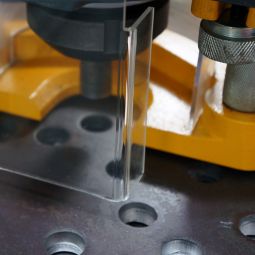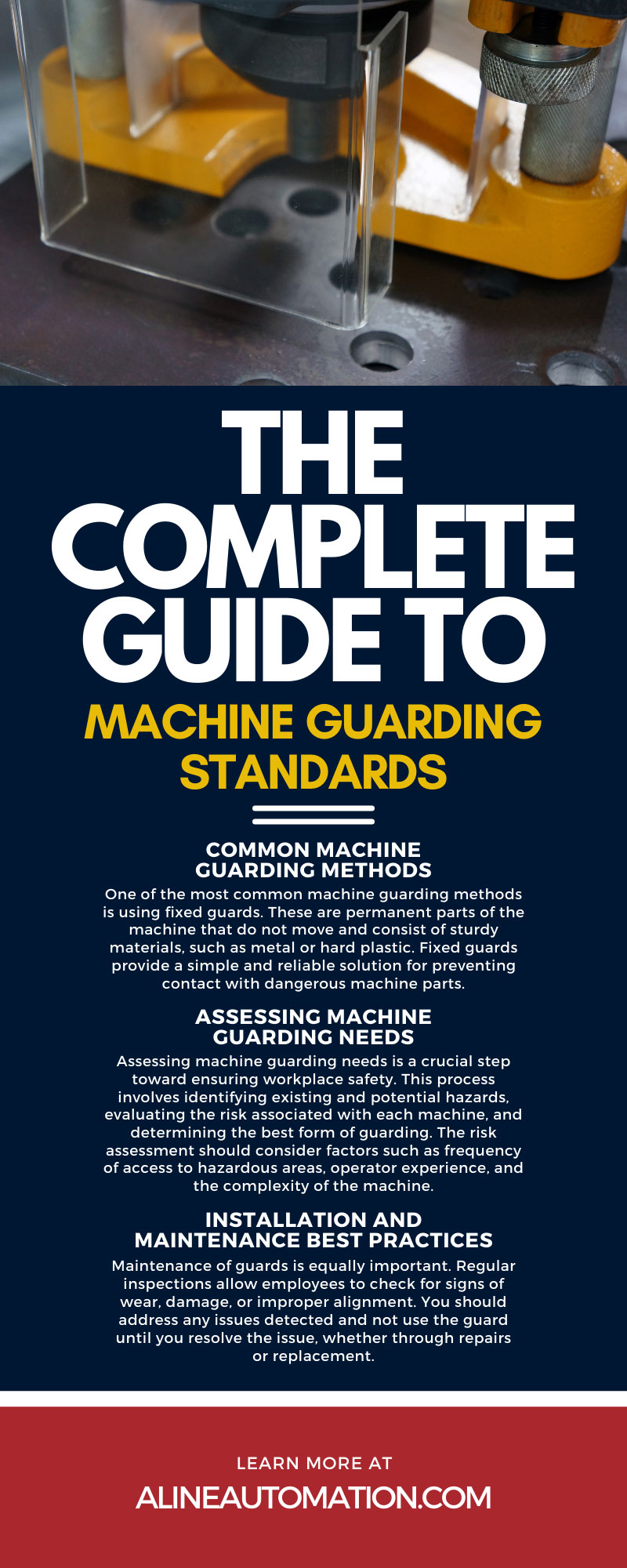
This comprehensive guide to machine guarding standards guide will provide a clear understanding of the safety standards and regulations governing machine guards’ use in various industries. Adherence to these standards is essential for preventing accidents and injuries while maintaining compliance with occupational health and safety legislation.
Whether you’re a machine operator, safety officer, or business owner, this guide to machine guarding standards can serve as a valuable resource for ensuring workplace safety and compliance.
Machine guarding uses physical barriers or guards to protect workers from hazards created by moving machinery. It involves enclosing dangerous machine parts, such as gears, belts, and other moving components that could cause harm if they touch an operator. Machine guards also serve as a barrier to prevent workers from accidentally entering hazardous areas during operation.
Machine guarding can take various forms, such as fixed guards, interlocked barriers, and light curtains. The type of guard used depends on the specific hazards present in the machine and its surrounding environment.
One of the most common machine guarding methods is using fixed guards. These are permanent parts of the machine that do not move and consist of sturdy materials, such as metal or hard plastic. Fixed guards provide a simple and reliable solution for preventing contact with dangerous machine parts.
Another widely used method is the use of interlocked guards. Unlike fixed guards, interlocked guards connect to the machine’s power source. When the guard is open or disconnected, the machine automatically shuts down, providing immediate protection to the operator.
Light curtains are another form of machine guarding. They use sensors to detect if a person or object is in a hazardous area and immediately shut down the machine to prevent accidents. It’s important to remember that the choice of machine guarding method depends on the specific hazards associated with each machine.
Assessing machine guarding needs is a crucial step toward ensuring workplace safety. This process involves identifying existing and potential hazards, evaluating the risk associated with each machine, and determining the best form of guarding. The risk assessment should consider factors such as frequency of access to hazardous areas, operator experience, and the complexity of the machine.
Once you evaluate the risks, you can select appropriate guarding methods. Employers should properly install and maintain guards and provide employees with safety training regarding the guards. Moreover, you should periodically reassess the guarding to address any changes in the working environment or process. Remember, a comprehensive approach toward machine guarding can significantly reduce the risk of accidents and ensure compliance with safety regulations.
The installation and maintenance of machine guards should follow certain best practices. Upon installation, it is crucial to ensure that guards do not obstruct the operator’s view of the work area and do not impede the operation of the machine. Additionally, the machine should not operate unless the guards are in place.
Maintenance of guards is equally important. Regular inspections allow employees to check for signs of wear, damage, or improper alignment. You should address any issues detected and not use the guard until you resolve the issue, whether through repairs or replacement.
Finally, remember that safety does not stop at installation and maintenance. It’s vital to cultivate a safety-oriented culture in the workplace. You can achieve this through proper training and regular audits to ensure you meet all safety standards. By following these best practices, one can greatly reduce the risk of machinery-related accidents in the workplace.
The Occupational Safety and Health Administration (OSHA) and the American National Standards Institute (ANSI) have specific guidelines for machine guarding to ensure worker safety. Compliance with these standards is crucial. OSHA regulations, such as the OSHA 1910.212 regulation, clearly state that all machines should have guards to prevent operator injury.
Additionally, ANSI standards, such as ANSI B11, provide a series of safety standards covering a wide array of machine tools, with comprehensive guidelines on the proper installation, maintenance, and operation of machine guards. Noncompliance can lead to penalties, including fines and operational restrictions. More importantly, it puts workers’ lives at risk. Hence, understanding and adhering to both OSHA and ANSI standards is key to maintaining a safe and legally compliant workplace.
Developing safe work procedures is integral to maintaining a secure and efficient working environment. These procedures, tailored to the specific operations of each machine, provide a step-by-step guide for operators, ensuring the safe operation and maintenance of machinery. Safe work procedures should outline the potential hazards related to each stage of operation, the preventive measures to mitigate these risks, and the necessary personal protective equipment required.
They should also incorporate machine guards and how to use them correctly. Worker training is key to ensuring that all employees know the safe operating procedures and can competently implement them. Remember, the objective of these procedures is to ensure workplace safety and foster a culture of safety among all employees.
Machine guarding plays a pivotal role in ensuring workplace safety and legal compliance. Adhering to the outlined standards and practices protects operators from preventable accidents and promotes a culture of safety within the organization. Each step contributes to a safer and more efficient working environment, from identifying hazards and assessing risk to choosing the right guarding methods and following OSHA and ANSI standards. Above all, remember that safety should be an ongoing process. Stay safe and keep your workforce safe.
If you’re looking for machine guarding solutions, A-Line Automation offers a wide range of products that comply with OSHA and ANSI standards. Contact us today for more information on our machine-guarding solutions.
